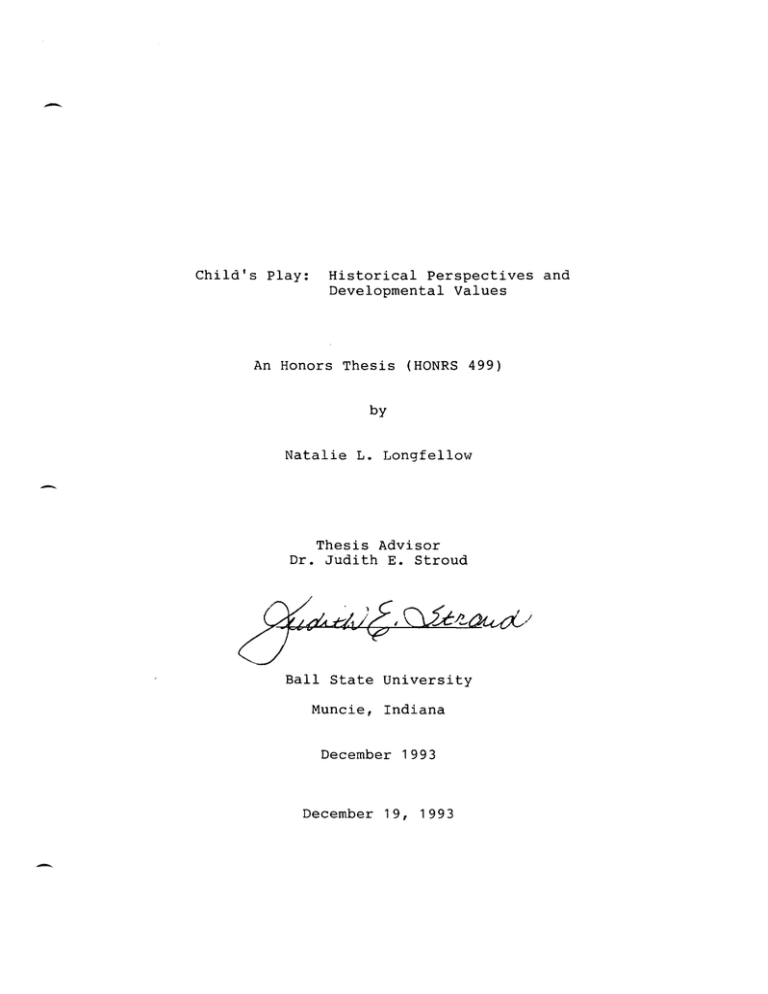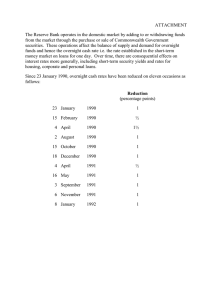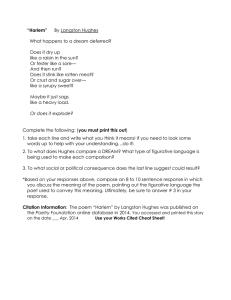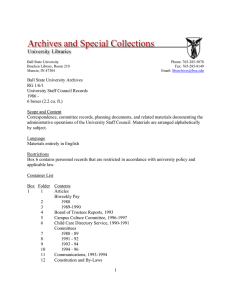-
advertisement

- Child's Play: Historical Perspectives and Developmental Values An Honors Thesis (HONRS 499) by Natalie L. Longfellow Thesis Advisor Dr. Judith E. Stroud Ball State University Muncie, Indiana December 1993 December 19, 1993 C~.i: --r . . . . . c..'1 tk.: -Abstract Purpose of Thesis This research paper on child's play is comprised of two components: historical perspectives and developmental values. Encompassed in the section on historical perspectives are (a) definitions of play, (b) historical accounts of play, and (c) theories of play both classical and modern. The second half of this paper discusses how play fosters and enhances the cognitive, social, emotional, and physical development of young - children. Acknowledgements Thanks to all of my family and friends who supported and encouraged me throughout this thesis project. An extra special thanks to Dr. Judith E. Stroud who advised and assisted me in the planning, revising, and finalizing of this project. I especially thank Dr. Stroud for her faithfulness and perseverance in working with me. 1• - . Child's Play: Historical Perspectives and Developmental Values "Play is universal, knowing no natural or cultural boundaries, peculiar to all ages and all races, subject to description yet defying definition; essential to the development of thought and language, yet neither; central to the transmission of culture, yet transcending culture" (Frost, 1985, p. ix) • Play is easy to recognize, but very hard to define (Johnson, 1987). In fact, many have attempted to narrow this broad concept. Yet, "no one has formulated a definition of play, especially child's play, which includes everything it is and leaves out everything it isn't" (Piers, 1980, p.11). Even in abridged dictionaries, "play's" listing contains numerous descriptions. Definitions of Play Some educators have defined playas a single idea such as: the work of children, an expenditure of surplus energy, or simply an activity that children do just for enjoyment. In contrast, other educators and philosophers have developed more complex definitions. Froebel felt that play was "the natural unfolding of the germinal leaves of childhood." In addition, Hall held that play was the "motor habits and spirit of the past persisting in the present." -- Thirdly, Dewey's definition consisted of "activities not consciously performed for the sake of any result beyond themselves" (Sponseller, 1979, p.ll). 2. Despite the differences of opinion and complexity involved in their definitions, most educators and theorists have agreed that play consists of five essential characteristics (Hughes, 1991, p. 2): 1. 2. 3. 4. 5. Intrinsically motivated Freely chosen Pleasurable Nonliteral Actively engaged It has also been agreeable to many that if the activity fails to meet all of these criteria, then the activity can no longer be considered play. For example, if the activity is extrinsically motivated such as when assigned by a teacher, parent, or caregiver, then the activity is no longer play since if fails to meet the criterion of being intrinsically motivated. In addition, compulsory games and athletics are not categorized as play because they are extrinsically motivated and have assigned roles. Even if the act resembles play it cannot be described as play if it does not occur in a playful atmosphere (Hughes, 1991 ). To summarize, for centuries play has been easily recognized and considered a child's activity. Yet, many have had difficulty identifying this concept by means of a consistent definition. Therefore, play is usually described by the five criteria with which most agree. Essentially, play occurs "as long as children decide whether -- to be involved or not, when to start and when to stop their involvement, and when to switch activities" (Sponseller, 3. 1979, p.21). History of Play Depending on the era and geographical location, play has varied betwen being an acceptable and unacceptable part of children's lives. Evidence to support play's acceptance can be traced back as early as one thousand years before Christ's birth in cultures of the eastern Mediterranean world. Egyptian wall paintings depict children playing with balls, dolls, and jumping rope (Hughes, 1991). Worldwide attitudes toward children and play's acceptance shifted during the Renaissance period of 13001600 A.D. During this time, distinctions between adulthood and childhood vanished. Most children were active members of the workforce except for the fortunate elite children who attended school. Evidence that play existed during this period can be attributed to the dawning of the toy industry. Kites, tops, lead soldiers, wooden dolls, and glass animals were popular toys at the time. Yet, due to the-delicacy and elaborateness of their design, toys seemed more adultlike than childlike (Hughes, 1991). However, children did engage in play during this period. Evidence to support this may be found in Pieter Brueghel's paintings which depicted children's sixteenth century games of pin-the-tail-on-the-donkey, blindman's bluff, and leap-frog. Other popular activities were blowing bubbles, chasing butterflies, riding, and hunting (Weiss, 1991), 4. - although, adults did little to encourage this behavior. During the seventeenth century, Europeon cultures differed in their views concerning children's play. Two countries with distinct views were France and Great Britain. In the early seventeenth century, France maintained the Renaissance attitude that there was no distinction between adults' and children's worlds (Hughes, 1991). In fact, play and work were considered to be synonymous. Then in the late seventeenth century, childhood and adult games were identified as physical games and intellectual games respectively. Moreover, work was designated as an adult activity and play was considered a child's activity (Hughes, - 1991 ) • Meanwhile, Britain began acknowledging the special needs of chidren. However, hard work and self-discipline were emphasized over play (Hughes, 1991). Britain further supressed play during the mid and late eighteenth century; public play, such as running races, was illegal. Play in the United states has been influenced both by the French and British, but not to resemble one particular Europeon attitude over another. Initially, groups of immigrants in the New World favored and practiced beliefs similar to those held in the home countries. Discipline and instruction were encouraged over play which was considered a non-evil distraction (Hughes, 1991). - Likewise, the Puritans were in tune and sensitive to the special needs and developmental differences between adults 5• - . and children. One need in particular, was the need for playing games. The pre-revolutionary games in Colonial America included kite flying, fishing, swimming, and shooting marbles. In addition, blindman's bluff, cricket, baseball, hopscotch, and leap-frog were also common games. Toy acquisition was popular at this time, too. "The first toy a boy had in Colonial America was something he would carry to his grave, a jackknife of highest quality" (McCullagh, 1991, p.22). The primary use of the jackknife was to whittle toys such as whistles, wheels, and tools. However, the act of whittling for pleasure diminished when items of necessity for the farm and home were needed. Boys then contributed by carving items such as wagon spokes, tool handles, pegs, rakes, and plows (McCullagh, 1991). Another popular practice was the importation of toys from foreign countries. The toys that were most frequently selected as mementos were China dolls, cornstalk stuffed dolls, whistles, and tops (McCullagh, 1991). Eventually, the motive behind importing toys became skewed and instead was focused upon as a symbol of social status. According to McCullagh (1991), "before the Revolution, the status symbol for rich and doting parents in Philadelphia and Chester counties was imported toys for children" (p.23). Moreover, a Boston trading company was considered the Nieman-Marcus and P.A.O. Schwarz of Colonial America where the wealthy parents purchased toys for their children 6. - (McCullagh, 1991). Overall, in the nineteenth century in the United states, the emphasis regarding children included strong parental authority. On the east coast, the British influence was observed in that children were encouraged to practice self-control by repressing personal feelings. Moreover, children were encouraged to master their environment. Toys were still prevalent, but children were discouraged from partaking in play activities. At the same time, the French influence was apparent in the Midwest and South. In these regions, childhood was viewed as a separate entity and play among children was greatly accepted (Hughes, 1991). - On the whole, the attitude concerning early American play is difficult to pinpoint due to the ambivalent views expressed by thoses in various areas of the country. It is obvious that the British and French were the primary influences on American play. Even so, the extent of the influence that was adapted and incorporated by the Americans is immeasurable. The freedoms of play experienced by American children fall somewhere in between their counterparts of Britain and France. Classical Theories of Play Classical theories of play emerged prior to World War I and attempted to explain the causes of play. -- The following four theories are categorized as classical: (a) surplus energy, (b) recreation, (c) practice, and (d) 7. -- recapitulation. In 1854, Friedrich von Schiller, a German poet and philosopher, developed a theory of play which correlated play with expending energy known as the Surplus Energy Theory. Schiller contended that a living thing generates a certain amount of energy to meet survival needs. After the needs are met, the remainingd energy must be expended. He proposed that play is the avenue for eliminating the surplus energy. Schiller often shares the credit of this theory with Herbert Spencer, a British philosopher, who recycled and promoted the theory in 1873. A contrasting theory to the Surplus Energy Theory is the Recreation also known as the Relaxation Theory. Proposed by Moritz Lazarus, a German poet, this theory argued that the purpose of play is to restore energy that has been expended in work. Lazarus believed that work activities deplenish energy stores and create an energy deficit. Therefore, play is an appropriate activity to replenish energy stores since it is considered an opposite activity of work. In 1901, a third theory, the Practice or Pre-exercise Theory, was introduced by Karl Groos, a professor of philosophy. Groos theorized that play serves to strengthen instincts needed for the future. Children playing house is a common activity and prime example of this type of play. Moreover, he believed that through playing house children are preparing for the domestic aspect of adulthood 8. (Hughes, 1991). The Recapitulation Theory was developed in 1920 by G. Stanley Hall who was an American psychologist and the father of the North American child psychology movement. According to this theory, engaging in play allows an individual to recapitulate or reenact the developmental stages of the human race as they occurred in human evolution (Johnson, 1987). Hall held that the purpose of play is to rid children of primitive instincts unnecessary for modern life. He exemplified this with an analogy of a baby crawling to refer to a primitive being walking on all fours (Hughes, 1991). -- The classical theories were important because they marked the dawning of play research and offered a reason for the existence of play. However, "none of the classical theories provide an adequate base for explaining play in all situations, nor do they adequately explain the existence of any content or thematic materials in the play of children" (Sponseller, 1979, p. 17). Modern ~heories of Play Not only were attitudes changing in Europe concerning children and play, but the United States experienced a shifting of ideas as well. In the early twentieth century, parents began expressing more interest in their children's feelings and perspectives. - In addition, a child study movement emergered particulary in the area of child development. Thirdly, the theory of Behaviorism was born 9. and with that positive views of play. This led to the development of another set of theories labeled the modern theories. Also referred to as contempory theories, these modern theories served three purposes. First of all, they tried to explain the cause for the existence of play. Secondly, they tried to determine play's role in child development. Finally, they specified antecedent conditions that cause play behavior (Johnson, 1987). The modern theories are categorized into three distinctions: (a) psychoanalytic, (b) cognitive-developmental, and (c) arousal modulation. The three main contributors to a Psychoananlytic Theory of play are Sigmund Freud, Anna Freud, and Erik Erikson. Overall, these theorists beleived that play was essential to a child for reducing anxiety via children gaining a senese of control over the world and expressing forbidden impulses in an acceptable manner (Hughes, 1991). Sigmund Freud, an Austrian psychiatrist, and his daughter, Anna, collectively theorized that the value of play is primarily emotional in that it allows children to reduce anxiety. According to the Freuds, the two types of anxiety which occur in infancy and throughout childhood are objective and instinctual. fear of the external world. Objective anxiety is the For example, when children role-play the fear of abandonment, they put themselves in control of the situation. In this instance, play has a cleansing effect by allowing children to rid themselves 10. of negative feelings associated with a traumatic event (Johnson, 1987). In contrast, instinctual anxiety is the fear of expressing certain behaviors which can be viewed as being frowned upon by adults. Such behaviors include anger, unreasonable fear, sexual curiosity, messiness, and destructiveness. Through play, children are able to deal with unpleasant events and explore the unwelcome feelings of adults without the repercussions of disapproval (Hughes, 1991). Although categorized with the Freuds as being psychoanalytic, Erik Erikson proposed a quite different theory of play. Erikson equated playas an ego building function since it enhances the development of physical and social skills and children's self-esteem (Hughes, 1991). Play, then according to Erikson, progresses through stages that mirror children's psychosocial development. In the first year of life, play occurs as an exploration of one's own body via sensory and motor skill recognition known as autocosmic play. By the second year, play can be descrihed as microspheric where one acquires mastery over objects and toys. Play progresses throughout the preschool years to a macrospheric state in which one plays with one's peers. These progressive steps are pertinent in strengthening the children's egos and providing for social success (Hughes, 1991). In addition, fantasy and reality ,- play are participated in which create model situations that help children master the demands of reality. 11 • - In the Cognitive-Developmental Approach, play is portrayed as a tool for facilitating intellectual growth. Since play provides a relaxed and non-threatening atmosphere, children are able to solve a variety of problems. The knowledge gained in a play situation can then be applied when children are confronted with solving more complex problems of the real world (Hughes, 1991). Jean Piaget, a Swiss biologist and philosopher, proposed that play was not synonymous with learning, but a facilitator of learning. Piaget believed that the primary function of living things is to adapt to their environment. He also defined adaptation as having two procesesses: .- assimilation and accommodation. The former is defined as taking new material from the outside world and fitting it into one's already existing structures. For example, bringing new ideas, concepts, and points of view into our existing structures so that they eventually become incorporated into our own views. On the other hand, accommodation is the adjusting of the structure in reaction to the newly incorporated ideas (Hughes, 1991). Furthermore, Piaget contended that for physical and intellectual growth to occur both assimilation and accommodation must be present. However, in a play situation, assimilation dominates accommodation. Therefore, play involves a consolidation of physical and mental - activities that have been previously learned. Finally, "play facilitates learning because it exposes a child to 1 2. - new experiences and new possibilities for dealing with the world" (Hughes, 1991, p. 21). The Arousal Modulation Theory, which was developed by Berlyne (1960) and modified by Ellis (1973) contends that play is caused by a need or drive in our central nervous system to keep arousal at an optimal level. According to this theory, when we become over-stimulated our arousal reaches an uncomfortable level. In order to stabalize our arousal level we can acquaint and familarize ourselves with the objects causing the over-stimulation through exploration and manipulation of the objects. In contrast, if we are under-stimulated to a point of boredom, - play then can serve to increase stimulation to an optimal level. Through play, objects and actions may be used in new and unusual ways which maintain an interest and stimulation for that object (Johnson, 1987). Values of Play Despite the differences in definitions and theories, many theorists and educators come together on one aspect of play---its value to children. "Play is valuable to the young child primarily as a medium for learning" (Sponseller, 1979, p. 2). This learning which children benefit through play can be categorized into four developmental areas: (a) cognitive, (b) social, (c) emotional, and (d) physical. Play contributes to each uniquely and independently. Play and Cognitive Development. One value of play is that it aids in developing children's cognitive or 13. thinking abilities. "Children have been shown to acquire knowledge most easily through play across a variety of contexts" (Barnett, 1990, p. 139). Three cognitve skill areas enhanced through play are (a) problem solving, (b) language and communication, and (c) mathematic concepts. During the course of play, problem solving skills are introduced, practiced, and refined. An example of a child's play situation that would require proglem solving skills occurs when two children reach a point of disagreement during dramatic play. to play the same adult role. Both children want Problem solving skills are necessary to determine who will actually play the sought - role and who will playa different role. Finally, the children come to an agreement and the problem is solved. Language and communication skills are also developed in the context of play. "Children learn about and build language and literacy skills as they use language and symbols in their pretend play" (Guddemi, 1992, p. 4). The opportunity to practice and develop language and communciation skills can be found in dramatic play. When choosing a theme and part in which to role-play, children must use language to communicate with one another. Moreover, throughout the course of role-playing, children practice and develop language and communciation skills to relay information to one another and to convey essential - insight to their characters. Finally, children use symbols as they select objects to represent other things. For 14. ~-- example, while role-playing a family living situation, one child might select a block to represent a scrub brush. This idea of using symbols to represent things carries over into language development. of language. Symbols are the essence For example, sounds are symbolized by letters. Moreover, single thoughts and complete thoughts are symbolized by words and sentences respectively. Additionally, mathematical concepts are naturally present and contribute to cognitive development during play. The concept of numerosity is learned by children through the manipulation of blocks or sets of like objects (Guddemi, 1992). - Moreover, "it is speculated that by exploring and manipulating objects in play, individuals learn the properties of those objects as well as their potential for application to various other problem situations" (Barnett, 1990, p. 139). Simply, through play, children encounter and acquaint themselves with concepts of counting, matching, sorting, and one-to-one correspondence which can be applied later in a more structured math situation. Depending on the activity, one or more concepts may be applicable. For example, a child putting together a puzzle which is shaped like a caterpillar and each segment (individual puzzle piece) has a numeral on it which correlates to a particular number of spots found within the frame of the puzzle is practicing -, the concepts of counting and one-to-one correspondence. Secondly, a child given a tin of buttons is likely to 1 5. engage in exercises of matching by finding like buttons, sorting by separating buttons into groups with like attributes, and counting of button holes. by simply counting the number Thirdly, the concept of matching in an obvious example of using a play situation is apparent when playing the game of concentration. a deck of cards with various The object is for a player mates for a match. In this game, symbols are placed face down. to select two cards which are Depending on the cards, the concepts of counting and one-to-one correspondence may be an essential part in determining a match. Play and Social Development. - "Play has a key role in social development by providing a context in which children can acquire many important social skills such as turn-taking, sharing, and cooperation, as well as the ability to understand other people's thoughts, perceptions, or emotions" (Johnson, 1981, p. 99). Through play, children encounter many opportunities to practice cooperation naturally. coopera~ing One example of children is when two or more join forces to accomplish a goal such as building a snowman. In the instance of a child trying to roll the largest snowball, cooperation from another child is sometimes essential. The single child may not have the strength, but the two together can accomplish great deeds. A second example of children cooperating occurs when two or more work together to clean up an area such as a block center. Together the children 16. combine and direct their focus to accomplish a task that will benefit all of them. Like cooperation, turn-taking occurs naturally and frequently in a play setting. A child may encounter the need for turn-taking also when approaching a sand/water table that is already filled to capacity with children. The child then must wait and take his turn when an opening becomes available. In addition, participating in a board game also requires the skill of taking turns. In essence, turn-taking is needed when two or more children are engaged in play. Following the rules is fostered during play since "all social play is rule-governed" (Johnson, 1987, p. 99). Even a simple game of peek-a-boo has the rule of turn-taking. Likewise sociodramatic play has the rules of adopting a role and behaving consistently to that role. Children often design their own postulates which will govern their play. After the rules are in place children must then follow the rules in order to be a participant in that area. A child must be obedient otherwise the other children will notify him of his wrongdoing and remind him of the expected guidelines. Play provides many opportunities to practice the social skill of following the rules which is esential for survival as an adult in the real world. Play and Emotional Development. - Children benefit emotionally through play which provides a means of revealing, expressing, and resolving inner feelings. These 17. may be feelings of joy or frustration. Dramatic play and non-verbal play activities are natural sources of emotional release for children. For these reasons, "a child may use play therapeutically" (Garvey, 1990, p. 63). Through dramatic play, children can address inner conflict by recreating an incident and assuming the role of the antagonist. For example, if a child was punished for any particular reason, then in a dramatic setting, the child may assume the role of the adult who was responsible for administering the punishment. The child may then select a doll to commit the same act and then suffer consequences which mayor may not remain the same. - In this episode the child is able to vent anger, deal with frustration, and respond to the incident. Through play the child can resolve the dramatic incident as well as the actual incident. In addition, non-verbal play activities are sources of emotional release for children. Such activities might include drawing, painting, and/or manipulating modeling clay. -These mediums provide a means for revealing, expressing, and possibly even resolving conflict. These activities are especially appropriate for children having difficulty verbalizing emotions. Therefore, play can sometimes be a medium for exploring feelings and stabalizing a child's emotional development (Stallibrass, 1974). Play and Physical Development. Probably the most obvious benefit of play is physical development. Play 18. positively aids physical development in the areas of fine and gross motor coordination and caloric expenditure. Through active and mobile play, children use and develop coordination of their gross motor skills. Activities such as running, skipping, and jumping all require gross motor skills. Play in this instance provides a natural and fun way of developing these skills. However, some less mobile activities provide greater opportunities for fine motor skill development. Drawing, some painting, and coloring are only a few examples of activities which illustrate and enhance fine motor skill development. Some other examples include lacing cards, stringing beads, and snapping together constructing materials. In the ~ context of play, these skills can be practiced and more thoroughly developed while still presented in a fun, interesting, and exciting way to children. Secondly, physical development is enhanced through active, mobile play because of caloric expenditure. When calories are expended and not stored as fat, the percentage of a child's lean mass to his fat mass remains high. Through regular physical activity, the child is able to maintain a healthy body composition and therefore is less susceptible to obesity related diseases. Essentially, play then has a crucial role in fostering a person's longevity as well as physical development (Robbins, 1989). Summary To conclude, the concept of play is not a new 19. phenomenon. Its place in society has been known virtually since the birth of mankind. Yet, throughout the ages and still today, play's purpose is puzzling. "Philosophers debate its meaning, researchers study its forms and functions, and teachers ponder its place in the curriculum" (Dimidjion, 1992, p. 27). Philosophers, theorists, and educators of the past and present have earnestly tried to pinpoint a single definition and theory with which to describe play. Regarding a single explanation, it is evident that the educated minds agree to disagree. Depending on the individual, certain theories and definitions appeal more - to one's liking than others. A possible example of an appealing explanation is by Ian Fletcher, an editor of It's Child's Play: "Play involves children in freely chosen activities which develop skills, enables them to learn about relationships with their fellows and increases understanding of their character and potential. Play is ideal education for life with scope for enterprise, imagination, social contracts, and the need for rules" (McCullagh, 1978, p, 25). Two facts are certain regarding play. First of all, the study of childhood play is definately following an accelerated path. development. Secondly, play is beneficial to a child's Knowing these facts, educators do not need to know every minute detail concerning the history of play, but rather its developmental values for children. For 20. - it is "our responsibility to the children of the world to give them the best we have to give. To give children the opportunity to be children in their early years. And to give children the opportunity to play, grow, and learn." (Guddemi, 1992, p. 7). - 21 • References Barnett, L.A. (1990). "Developmental Benefits of Play for Children." Journal of Leisure Research, 22 (2), 138-153. Cartwright, S. (1988). "Play Can Be the Building Blocks of Learning." Young Children, 43 (5), 44-47. Coop, R.H. and Rotella, R.J. (1991). "Sport and Physical Skill Development in Elementary Schools: An Overview." Elementary School Journal, 91 (5), 409-412. Dimidjion, V.J. (1992). Play's Place in Public Education for Young Children. National Education Association of the U.S. Frost, J.L. and Sunderlin, S. (1985). When Children Play: Proceedings on the International Conferences on Play and Play Environments. Wheaton, MD: Association for Childhood Education International. Garvey, C. (1990). Play. Cambridge, MA: Harvard University Press. - Guddemi, M. (1992). "The Child's Right to Play." May 8, 1992 paper presented at UN Press Conference. Heidemann, S. and Hewitt, D. (1992). Pathways to Play. st. Paul, MN: Redleaf Press. Hughes, F.P. (1991). Children, Play, and Development. Allyn and Bacon. Johnson, J.E. et ale (1987). Play and Early Childhood Development. Scott, Foresman, and Company. Ladd, G.W. (1992). "Commentary: Play, Parenting, and Peer Partners: Keys to Understanding Children's Social Development?" Early Education and Development, 3 (4), 401-406. McCullagh, J.C. (1978). ~W~a~y~s~t~o~P~l~a~y~:__~R~e~c~r~e~a~t~l~'o~n~A~l~t~e~r~n~a~t~l~·v~e==s. Pennsylvania: Rodale Press, Inc. Piers, L. (1980). The Gift of Play: And Why Children Cannot Thrive Without It. New York: Walker and Co. Robbins, G. and Powers, D. et ale (1989). The Wellness Way of Life. Dubuque, IO: Wm. C. Brown Publishers. - Sawyers, J.K, and Rogers, C.S. (1988). Helping Young Children Develop Through Play: A Practical Guide for Parents, Caregivers, and Teachers. NAEYC. 22. -- Smilansky, S. (1968). The Effects of Sociodramatic Play on Disadvantaged Preschool Children. New York: John Wiley & Sons, Inc. Sponseller, D. (1979). Playas a Learning Medium. Washington, D.C.: NAEYC. Stallibrass, A. (1974). The Self-Respecting Child: A Study of Children's Play and Development. London: Thanes and Hudson. Staniford, D.J. (1982). Natural Movement for Children: Guidelines for Parents and Teachers on Play and Physical Activity. Dubuque, 10: Kendall/Hunt Publishing Co. Weis, L. et ale (1991). Critical Perspectives on Early Childhood Education. New York: State University Press. 23. Works Cited Barnett, L.A. (1990). "Developmental Benefits of Play for Children." Journal of Leisure Research, 22 (2), 138-153. Dimidjion, V.J. (1992). Play1s Place in Public Education for Young Children. National Education Association of the u.s. Frost, J.L. and Sunderlin, S. (1985). When Children Play: Proceedings on the International Conferences on Play and Play Environments. Wheaton, MD: Association for Childhood Education International. Garvey, C. (1990). Play. Cambridge, MA: Harvard University Press. Guddemi, M. (1992). "The Child1s Right to Play." May 8, 1992 paper presented at UN Press Conference. Hughes, F.P. (1991). Children, Play, and Development. Allyn and Bacon. Johnson, J.E. et ale (1987). Play and Early Childhood Development. Scott, Foresman, and Company. McCullagh, J.C. (1978). Ways to Play: Recreation Alternatives. Pennsylvania: Rodale Press, Inc. Piers, L. (1980). The Gift of Play: And Why Children Cannot Thrive Without It. New York: Walker and Co. Robbins, G. and Powers, D. et ale (1989). The Wellness Way of Life. Dubuque, 10: Wm. C. Brown Publishers. Sponseller, D. (1979). Playas a Learning Medium. Washington, D.C.: NAEYC. Stallibrass, A. (1974). The Self-Respecting Child: A Study of-Children1s Play and Development. London: Thanes and Hudson.




